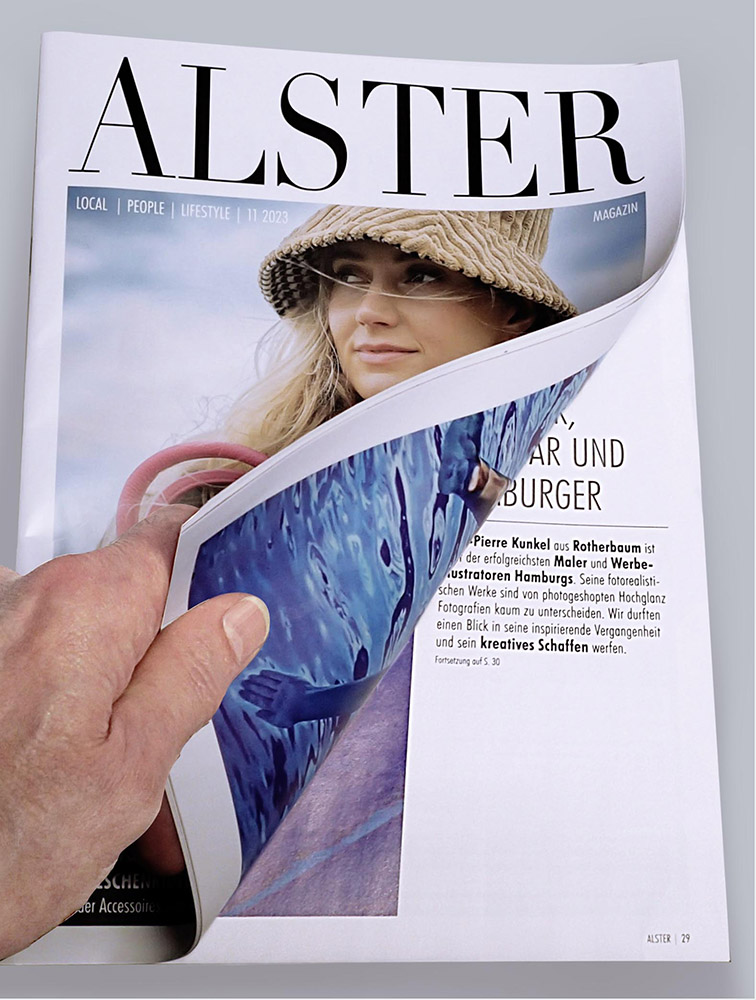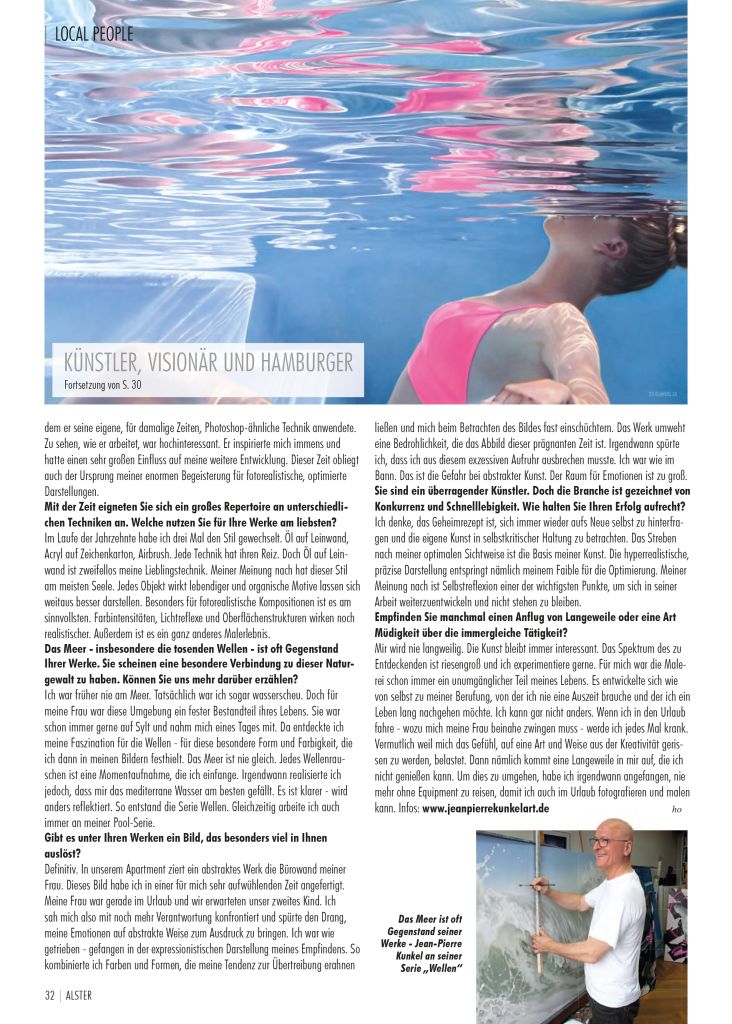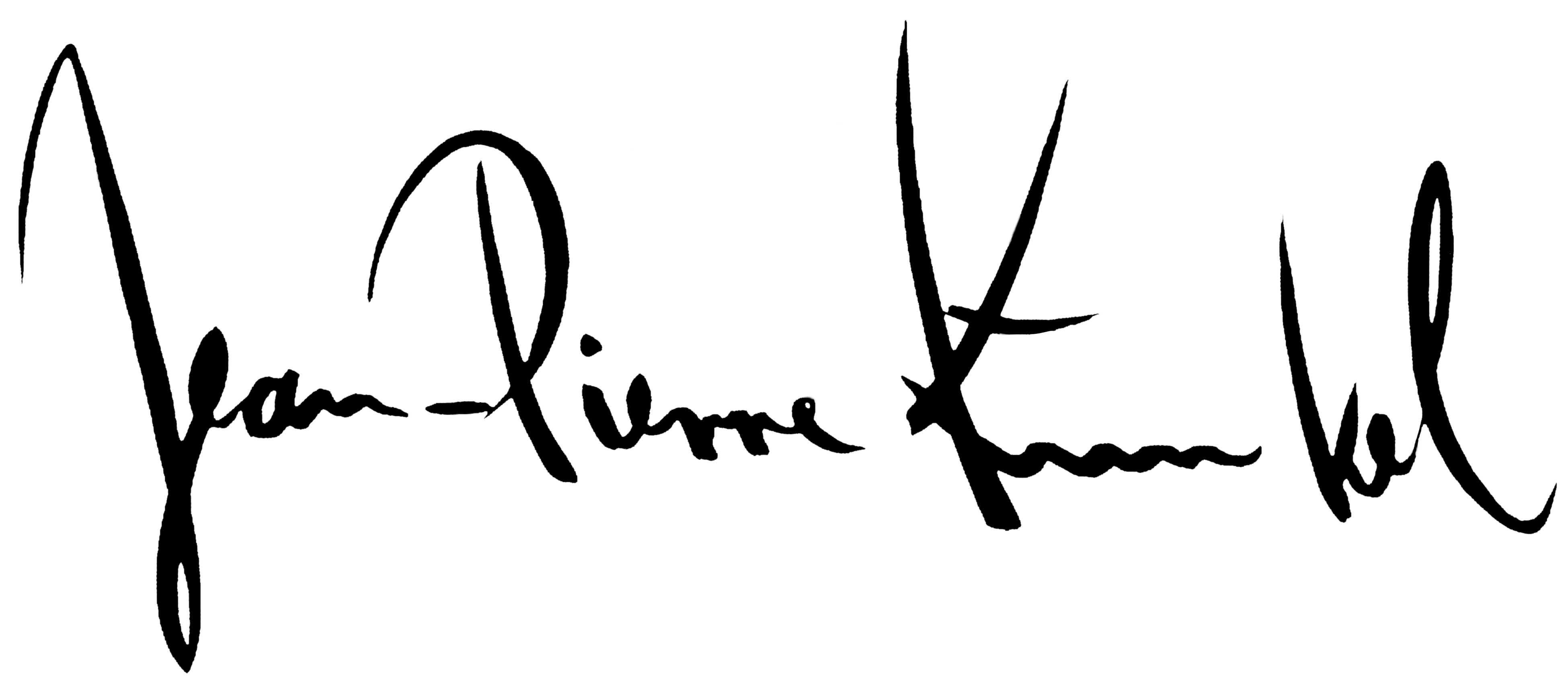Presse Artikel im Alster Magazin November 2023
ALSTER MAGAZIN November 2023


KÜNSTLER, VISIONÄR UND HAMBURGER
_________________________________________
Jean-Pierre Kunkel aus Rotherbaum ist einer der erfolgreichsten Maler und Werbeillustratoren Hamburgs. Seine fotorealistischen Werke sind von photogeshopten Hochglanz Fotografien kaum zu unterscheiden. Wir durften einen Blick in seine inspirierende Vergangenheit und sein kreatives Schaffen werfen.


ARTIST, VISIONARY, AND HAMBURGER
ALSTER MAGAZINE: When and how did you first feel that your passion lies in art? Jean-Pierre Kunkel: I was born in France and came to Germany at the age of 7. Until then, I only spoke French. So, initially, I may not have been able to communicate perfectly – although I quickly learned German – but: I could draw. My classmates noticed this and thought it was great. I think at that point I realized that painting can be a form of communication. So, it is probably a deeply rooted certainty in me that I have a profession where I can be creative. You had the honor of assisting the world-famous graphic designer, photographer, and creative director Jean-Paul Goude in New York in the late 70s. How did this time shape your path? The collaboration was incredibly enlightening. 40 years ago, advertising illustration had a very special aura. What can now be constructed with Photoshop was once a high art. Jean-Paul Goude was ahead of his time. He had a unique, revolutionary way of making the optimization of reality the subject of his art. His images are fantastic. I really wanted to meet him in person. So, my agent put me in touch with him. Shortly after, I flew to New York and had the privilege not only to assist him but also to sleep in his guest room and immerse myself completely in his world. I met his then partner Grace Jones and even photographed her. She modeled for Jean-Pierre Goude in one of his most famous works, where he used his own, for that time, Photoshop-like technique. Seeing how he works was very interesting. He inspired me immensely and had a great influence on my further development. This time is also the origin of my enormous enthusiasm for photorealistic, optimized representations. Over time, you have acquired a large repertoire of different techniques. Which ones do you prefer to use for your works? Over the decades, I have changed my style three times. Oil on canvas, acrylic on drawing board, airbrush. Each technique has its charm. But oil on canvas is undoubtedly my favorite technique. In my opinion, this style has the most soul. Each object appears more alive, and organic motifs can be represented much better. It is most suitable for photorealistic compositions. Color intensities, light reflections, and surface textures appear even more realistic. It is also a completely different painting experience. The sea – especially the roaring waves – is often the subject of your works. You seem to have a special connection to this force of nature. Can you tell us more about it? I had never been to the sea before. In fact, I was even afraid of water. But for my wife, this environment was an integral part of her life. She had always enjoyed being on Sylt and one day took me with her. That’s when I discovered my fascination for the waves – for their special shape and color, which I then captured in my paintings. The sea is never the same. Each wave is a snapshot that I capture. Eventually, I realized that I prefer the Mediterranean water. It is clearer – reflects differently. This is how the Waves series was created. At the same time, I also work on my Pool series. Among your works, is there a painting that evokes a lot in you? Definitely. An abstract work adorns the office wall of my wife in our apartment. I created this painting during a very turbulent time for me. My wife was on vacation, and we were expecting our second child. So, I felt even more responsibility and had the urge to express my emotions in an abstract way. I was driven – caught in the expressionistic representation of my feelings. I combined colors and shapes that hinted at my tendency to exaggerate and almost intimidated me when looking at the painting. The work exudes a sense of threat, which is the reflection of that significant time. Eventually, I felt that I had to break free from this excessive turmoil. I was like under a spell. That is the danger of abstract art. The space for emotions is too large. You are an outstanding artist. However, the industry is marked by competition and fast-paced changes. How do you maintain your success? I think the secret is to constantly question yourself and critically examine your own art. Striving for my optimal perspective is the basis of my art. The hyper-realistic, precise representation stems from my passion for optimization. In my opinion, self-reflection is one of the most important points to continue developing in your work and not to remain stagnant. Do you ever feel a hint of boredom or a kind of fatigue from the same activity? I never get bored. Art always remains interesting. The spectrum of things to discover is huge, and I enjoy experimenting. Painting has always been an essential part of my life. It naturally evolved into my vocation, which I never need a break from and want to pursue for a lifetime. I can’t help it. When I go on vacation – which my wife almost has to force me to do – I get sick every time. Probably because the feeling of being torn away from creativity burdens me. That’s when a boredom arises in me that I cannot enjoy. To avoid this, I eventually started traveling with equipment so that I could photograph and paint even on vacation.

